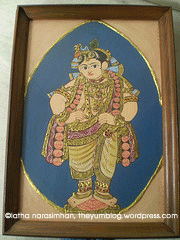We had a long weekend and I took to blog hopping and posting random musings – like this previous post on Nagapattinam with pictures of my family temple. While I was blog hopping I saw almost everyone showing off their cook books! After seeing Suganya’s Tassajara cook book, I had to muster some courage to show off my humble belongings! 🙂 . I have a modest collection of cook books. I gather most of my cooking knowledge from my mother and aunts, my friends and acquaintances and their mothers and patties, random people I meet on holidays like this person who cooks at a guest house in a remote hill station, chefs at marriages and functions at all kinds, cookery shows like that of Sanjeev Kapoor and now food bloggers and food websites. Having travelled throughout India, I have met a whole lot of interesting people and been introduced to their cuisine.
So here are my cook books with some memories. Hope you don’t find my narration boring! 😀
Just before my marriage, I was attending a Nirmal (a traditional art form) painting class, around 5 km from my home. I wanted to join the bakery course conducted in the same place. One day on my way back from the classes I lost my purse with around Rs.7! Rs. 7 in those days was a loooooooooot of money for a youngster. I was so upset that I created a scene after reaching home! My mother got scared seeing my crest fallen face and refused to send me to the class from the next day. I somehow convinced her and joined a painting class closer home, though I was pretty upset about not being able to attend the baking class. Since I was so keen to learn baking my Appa who travelled a lot as a part of his job at Telecoms bought a cake book from Manneys, Poona for Rs. 50. Yes 26 years back the book was only Rs. 50 !!
Woman’s Own Cook Book of Cake Decorating and Cake Making is a large collection of recipes published by Hamlyn Publishing, London. No author/s have been mentioned anywhere in the book. This book was my introduction to the world of baking. Though my mother baked eggless cakes in a round gas oven, I learnt baking and decoration from this book! For the rich fruit cake I follow the recipe from this book, omitting rum.
The other book I cherish is my handwritten note book which is a treasure house of recipes from my mom and aunts, with exact measurements and rare dishes! This is the only book I follow 100%, with no modifications to the recipes. 🙂

I am also fond of the Tupperware cook book in which some of my recipes were published. 😉
I have a few cook books by Tarla dalal – some of them are with my daughter now. I like her North Indian recipes – simple and practical. Supersoft naans with Navratna kurma is the first dish I prepared from her books. TarlaDalal comes across as a simple and lovable person in her cookery shows! 🙂
I would like to send this as my entry for “Show me your Cook Book” the event hosted by Nags (Nags, please do accept my entry even if it is 3 days late!:)


















 Read the Round up of all Entries Here
Read the Round up of all Entries Here